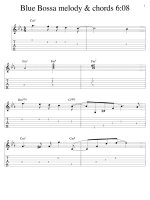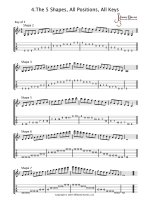5 containment in unions and methods tủ tài liệu bách khoa
Bạn đang xem bản rút gọn của tài liệu. Xem và tải ngay bản đầy đủ của tài liệu tại đây (630.87 KB, 154 trang )
Containment in Unions
and Methods
1
Part 1: Containment in union
2
Managing Inventory
• A sales clerk in a toy store needs to
know not only the name of the toy, but
also its price, warehouse availability.
• The representation of an inventory as
a list of toys.
3
Data definition
• Inventory is one of:
– a empty
– a construct of Toy Inventory
• The class of Inventory is a union:
– Inventory, which is the type of all kind of inventories;
– MTInventory, which represents an empty inventory;
and
– ConsInventory, which represents the construction of a
new inventory from a Toy and an existing Inventory.
4
Class diagram
• An MTInventory
class don't have
any fields for it.
• A ConsInventory
class requires two
field definitions: one
for the first Toy and
one for the rest of
the Inventory.
self-referential
Inventory
MTInventory
ConsInventory
- Toy first
- Inventory rest
Toy
- String name
- double price
- int available
5
Define classes an constructors
public interface Inventory {
}
public class MTInventory implements Inventory {
}
public class ConsInventory implements Inventory {
private Toy first;
private Inventory rest;
public ConsInventory(Toy first, Inventory rest ) {
this.first = first;
this.rest= rest;
}
}
6
Define classes and constructors
public class Toy {
private String name;
private double price;
private int available;
public Toy(String name, double price,
int available) {
this.name = name;
this.price = price;
this.available = available;
}
}
7
Test Constructor
public class InventoryTest extends TestCase {
public void testConstructor() {
Toy doll = new Toy("doll", 17.95, 5);
Toy robot = new Toy("robot", 22.05, 3);
Toy gun = new Toy ("gun", 15.0, 4);
Inventory empty = new MTInventory();
Inventory i1 = new ConsInventory(doll, empty);
Inventory i2 = new ConsInventory(robot, i1);
Inventory all = new ConsInventory(gun, i2);
System.out.println(all);
Inventory all = new ConsInventory(doll,
new ConsInventory(robot,
new ConsInventory(gun, new MTInventory())));
System.out.println(all);
}
}
8
Print the content of an inventory
Q: How can we print the content of an object.
A: overwriting toString() method of class Object.
Q: Do we need to add toString() in Inventory
class?
A: No !
9
toString() in classes
// inside of MTInventory class
public String toString() {
return "";
}
// inside of ConsInventory class
public String toString() {
return this.first.toString() + "\n"
+ this.rest.toString();
}
// inside of Toy class
public String toString() {
return "name: " + this.name
+ ", price: " + this.price
+ ", available: " + this.available;
}
}
10
Managing a Runner’s Logs Example
• Develop a program that manages a runner's training
log. Every day the runner enters one entry
concerning the day's run. Each entry includes the
day's date, the distance of the day's run, the
duration of the run, and a comment describing the
runner's post-run disposition.
• Naturally the program shouldn't just deal with a
single log entry but sequences of log entries.
11
Data definition
• The class of Logs is a union:
– ILog, which is the type of all logs;
– MTLog, which represents an empty log; and
– ConsLog, which represents the construction of a new log
from an entry and an existing log.
12
Class diagram
ILog
self-referential
MTLog
ConsLog
- Entry first
- ILog rest
Entry
- Date date
- double distance
- int duration
- String comment
Date
- int day
- int month
- int year
13
Define classes an constructors
public interface ILog {
}
public class MTLog implements ILog {
}
public class ConsLog implements ILog {
private Entry first;
private ILog rest;
public ConsLog(Entry first, ILog rest) {
this.first = first;
this.rest = rest;
}
}
14
Define classes and constructors
public class Entry {
private Date date;
private double distance;
private int duration;
private String comment;
public Entry(Date date, double distance,
int duration,
String comment) {
this.date = date;
this.distance = distance;
this.duration = duration;
this.comment = comment;
}
}
15
Define classes and constructors
public class Date {
private int day;
private int month;
private int year;
public Date(int day, int month, int year) {
this.day = day;
this.month = month;
this.year = year;
}
}
16
Test Constructor
public class LogTest extends TestCase {
public void testConstructor() {
Entry e1 =
new Entry(new Date(5, 5, 2005), 5.0, 25, "Good");
Entry e2 =
new Entry(new Date(6, 6, 2005), 3.0, 24, "Tired");
Entry e3 =
new Entry(new Date(23, 6, 2005), 26.0, 156, "Great");
ILog empty = new MTLog();
ILog l1 = new ConsLog(e1, empty);
ILog l2 = new ConsLog(e2, l1);
ILog l3 = new ConsLog(e3, l2);
System.out.println(l3);
ILog all = new ConsLog(e1, new ConsLog(e2,
new ConsLog(e3, new MTLog())));
System.out.println(all);
}
}
17
toString() method
// inside of ConsLog class
public String toString() {
return this.first.toString() + " \n" + this.rest.toString();
}
// inside of MTLog class
public String toString() {
return "";
}
// inside of Entry class
public String toString() {
return "date: " + this.date.toString()
+ ", distance: " + this.distance
+ ", duration: " + this.duration
+ ", comment: " + this.comment;
}
// inside of Date class
public String toString() {
return this.day + "/" + this.month + "/" + this.year;
}
18
Recall restaurant example
• Develop a program that helps a visitor navigate
Manhattan's restaurant scene. The program must be
able to provide four pieces of information for each
restaurant: its name, the kind of food it serves, its
price range, and the closest intersection (street and
avenue).
• Clearly, the visitor assistant should deal with lists of
restaurants, not just individual restaurants. A visitor
may, for example, wish to learn about all Chinese
restaurants in a certain area or all German
restaurants in a certain price range.
19
Class diagram
ILoRestaurant
Restaurant
MTLoRestaurant
ConsLoRestaurant
- Restaurant first
- ILoRestaurant rest
- String name
- String food
- String priceRange
- Intersection intersection
Intersection
- int avenue
- int street
20
Define classes and constructors
public interface ILoRestaurant {
}
public class MTLoRestaurant implements ILoRestaurant {
}
public class ConsLoRestaurant implements ILoRestaurant {
private Restaurant first;
private ILoRestaurant rest;
public ConsLoRestaurant(Restaurant first,
ILoRestaurant rest) {
this.first = first;
this.rest = rest;
}
}
21
Define Restaurant class
public class Restaurant {
private String name;
private String food;
private String priceRange;
private Intersection intersection;
public Restaurant(String name, String food,
String priceRange,
Intersection intersection) {
this.name = name;
this.food = food;
this.priceRange = priceRange;
this.intersection = intersection;
}
}
22
Define Intersection class
public class Intersection {
private int avenue;
private int street;
public Intersection(int avenue, int street) {
this.avenue = avenue;
this.street = street;
}
}
23
toString() method
// in class ConsLoRestaurant
public String toString() {
return this.first.toString() + " \n" + this.rest.toString();
}
// in class MTLoRestaurant
public String toString() {
return "";
}
// in class Restaurant
public String toString() {
return "Name: " + this.name + ", food: " + this.food
+ ", range price: " + this.priceRange
+ ", intersection: " + this.intersection.toString() + "\n"
+ this.rest;
}
// in class Intersection
}
public String toString() {
return "avenue: " + this.avenue
+ ", street: " + this.street;
}
24
Test Constructor
public class ConsLoRestaurantTest extends TestCase {
public void testConstructor() {
Restaurant r1 = new Restaurant("Chez Nous",
"French", "exp.", new Intersection(7, 65));
Restaurant r2 = new Restaurant("Das Bier",
"German", "cheap", new Intersection(2, 86));
Restaurant r3 = new Restaurant("Sun",
"Chinese", "cheap", new Intersection(10, 13));
ILoRestaurant empty = new MTLoRestaurant();
ILoRestaurant l1 = new ConsLoRestaurant(r1, empty);
ILoRestaurant l2 = new ConsLoRestaurant(r2, l1);
ILoRestaurant l3 = new ConsLoRestaurant(r3, l2);
System.out.println(l3);
ILoRestaurant all = new ConsLoRestaurant(r1,
new ConsLoRestaurant (r2,
new ConsLoRestaurant(r3, new MTLoRestaurant())));
System.out.println(all);
}
}
25









